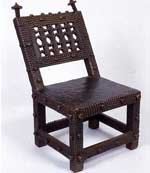VAM galleries including this work:
University of Kentucky Art Museum | Young at Art || VAM Home
African, Ghana, Asante
CHIEF’S CHAIR, late 19th century
Leather, brass, and wood; 27-1/2" X 16-1/8" X 21-1/4"
Purchase of the University of Kentucky Annual Giving Fund, 76.2
University of Kentucky Art Museum
This chief’s chair, decorated with imported upholstery nails, was derived from European prototypes introduced to Ghana by Dutch and Portuguese traders in the early 19th century. It was common for African rulers to adopt European objects as symbols of power, and a chief’s chair would be especially esteemed as a resting place of prior chiefs and the seat of governing authority.
About the Artist
The Asante (also referred to as Ashanti) people are the largest tribal ethnic group in Ghana. Chiefdoms in the area were consolidated into the Ashanti kingdom around 1700. According to cultural tradition, divine power was bestowed upon the Ashanti people through a Golden Stool that came down from the heavens; this stool is carefully protected as the holder of the soul of the nation.
The Ashanti are recognized as expert craftsmen and are known for metalwork, kente cloth, and stools and other items carved from wood. Their ceremonial stools come in many styles. Even today, the king has a chief woodcarver who is responsible for carving ceremonial sitting stools. Chairs such as this one are often highly elaborate and serve as signs of status, although they do not have the spiritual significance of the stools.
Classroom Ideas
Discussion: Would you have guessed that this chair is African? Why or why not? Why might African peoples have associated the objects introduced to their cultures by Europeans with power and influence? What skills and talents are required to create a chair?
Activity: Examine chairs representing a variety of styles, cultures, and historic periods. Design a chair that you would like to make.
Links
Learn more about the Asante people and their art at the online African Art Museum.
[www.zyama.com/asante/]
Several examples of woodcarvings by Nana Frimpong, chief carver to the king of the Asanti, are included in the Novica catalog.
[www.novica.com/art/furniture/stools-and-ottomans/index.cfm?c=106&l=3]
Learn more about life in Africa, including crafts traditions, at the Smithsonian’s African Voices site.
[www.mnh.si.edu/africanvoices/]
Michigan State University’s Exploring Africa! site includes ideas for an African studies curriculum.
[exploringafrica.matrix.msu.edu/students/stu_curriculummap.html]
You’ll find extensive links to more background information on Princeton Online’s African Art and History Links page.
[www.princetonol.com/groups/iad/lessons/middle/afrilink.htm]

